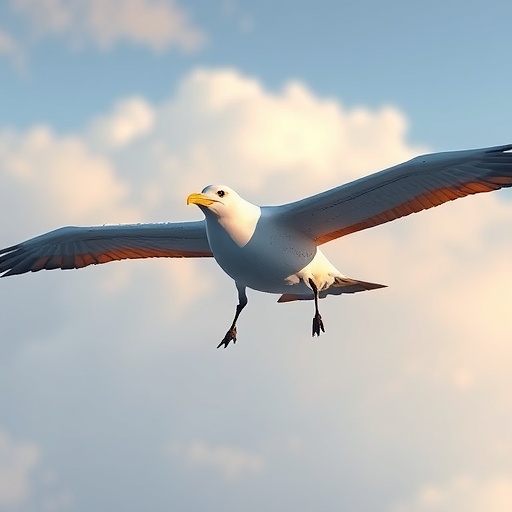
In the expansive realm of aerospace engineering, researchers are increasingly turning to nature for inspiration, and nowhere is this more evident than in the remarkable features of the albatross. Known for its impressive wingspan, which can reach up to 11 feet, the black-footed albatross has captivated scientists and engineers alike due to its exceptional mastery of dynamic soaring. This ability not only allows the albatross to cover vast distances with astonishing efficiency but also serves as a blueprint for the development of next-generation autonomous drones. As they navigate the open oceans, these birds display techniques that engineers are now seeking to replicate in the pursuit of enhanced aerodynamics and energy efficiency.
At the forefront of this innovative research is Assistant Professor Sameh Eisa from the University of Cincinnati, who has dedicated his efforts to understanding the intricacies of how albatrosses soar. With a substantial $700,000 grant provided by the Defense Advanced Research Projects Agency (DARPA), Eisa is leading a project aimed at transforming unmanned aerial vehicles (UAVs) through biomimicry—an engineering approach that draws inspiration from biological systems. Eisa’s research is centered on creating autonomous drones capable of replicating the impressive soaring capabilities of albatrosses.
Central to the albatross’s extraordinary flight is a technique known as dynamic soaring, which allows the birds to leverage varying wind currents effectively. This method involves a complex interplay of movement that includes tacking into the wind, gaining lift and altitude, and then cleverly utilizing gravitational forces to maintain speed as they glide downward. Eisa’s research team is pioneering a novel approach to dynamic soaring referred to as a “natural extremum-seeking system.” This groundbreaking methodology involves meticulously measuring the angles of pitch, yaw, and roll while simultaneously adjusting flight speed to optimize drone performance in real-time.
.adsslot_vIqtxY0yTG{width:728px !important;height:90px !important;}
@media(max-width:1199px){ .adsslot_vIqtxY0yTG{width:468px !important;height:60px !important;}
}
@media(max-width:767px){ .adsslot_vIqtxY0yTG{width:320px !important;height:50px !important;}
}
ADVERTISEMENT
Utilizing both computer simulations and biological insights, Eisa and his collaborators have uncovered that these ancient birds can solve intricate optimization problems with astonishing proficiency. Through the use of sensitive nostrils, albatrosses can detect changes in wind speed and direction, allowing them to make delicate and precise adjustments to their flight patterns. Eisa emphasizes that this sensory capability is crucial for maximizing energy efficiency during both ascent and descent, enabling these birds to fly with remarkable stamina and agility.
The implications of applying these natural principles to drone technology are substantial. Eisa believes that if engineers can decode the principles governing the albatross’s flight, they can unlock unprecedented efficiency in drone operations. Traditional drone designs often struggle against the wind, but the objective of Eisa’s research is to transform these challenges into opportunities—enabling drones that can harness the wind with the same skill and prowess as their avian counterparts. By modeling albatross-like behaviors, future machines may achieve significant enhancements in both flight range and energy conservation.
In collaboration with industry experts and academic partners, including the Massachusetts Institute of Technology, Eisa’s project intends to validate the innovative design principles derived from albatross flight in real-world environments. Initial testing will focus on the efficacy of these new flight control systems, comparing energy consumption between drones using conventional flight techniques and those employing dynamic soaring techniques inspired by the albatross. Eisa expects this research to illuminate the energy-saving potential of mimicking nature’s designs in technological applications.
As Eisa and his students delve deeper into the physics of albatross flight, they access a wealth of evolutionary knowledge honed over millions of years. Nature has dictated optimal adjustments for efficiency, allowing albatrosses to accomplish the remarkable feat of traveling hundreds of miles weekly. By the end of their lifespans, these birds accumulate distances equivalent to nearly twenty times the distance from the Earth to the moon. Such astounding metrics emphasize the need to adopt nature-inspired engineering principles to enhance drone technology and expand flight capabilities.
Eisa’s work embodies the broader trend of biomimicry in aerospace engineering, where nature’s designs are increasingly viewed as valuable resources for solving human engineering challenges. By leveraging the advantages of flight perfected through evolution, Eisa aims to create drones capable of more sustainable operations. These efforts not only have potential applications in defense but may also revolutionize commercial UAVs, enhancing their performance, reliability, and energy efficiency.
Eisa’s research serves as a compelling reminder that the natural world continues to inspire cutting-edge technologies. The blending of aerospace engineering with biological insights highlights the exciting future on the horizon for autonomous flight. Researchers and engineers stand on the brink of creating drones that can soar as effortlessly as albatrosses glide over open waters, making the dream of sustainable, long-range flight a tangible reality. This endeavor is a testament to the ingenuity inspired by the natural world and the boundless possibilities that lie within the realm of aerodynamics.
Through rigorous testing and collaboration, there is the potential for a breakthrough in how we understand and implement flight technology. The albatross may well be the key to unlocking new frontiers in drone capabilities, ushering in a new era where UAVs harness the winds with the skill and efficiency of nature itself. The insights gained from studying these remarkable birds could redefine standards for energy-efficient flight and substantially advance the field of autonomous aviation.
Subject of Research: Biomimicry in aerospace engineering through studying albatross flight dynamics.
Article Title: Harnessing the Winds of Change: How Albatross Flight is Inspiring the Next Generation of Drones
News Publication Date: October 2023
Web References: University of Cincinnati News
References: Not specified.
Image Credits: Michael Miller
Keywords
Aerospace engineering
Biomimicry
Dynamic soaring
Autonomous drones
Energy efficiency
Optimization problems
Tags: albatross-inspired flight technologyautonomous dronesbiomimicry in aerospace engineeringDARPA funding for drone researchdynamic soaring techniquesenergy-efficient UAV designenhancing drone aerodynamicslong-distance flight capabilitiesnature-inspired engineering innovationsnext-generation unmanned aerial vehiclesProfessor Sameh Eisa researchsustainable drone energy solutions





